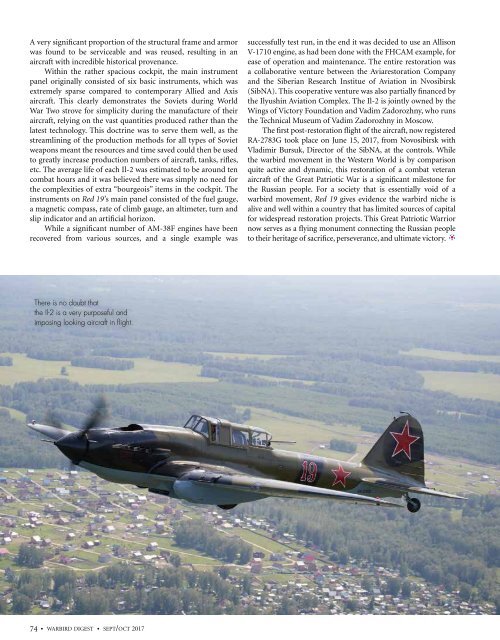WD74W2
Create successful ePaper yourself
Turn your PDF publications into a flip-book with our unique Google optimized e-Paper software.
A very significant proportion of the structural frame and armor<br />
was found to be serviceable and was reused, resulting in an<br />
aircraft with incredible historical provenance.<br />
Within the rather spacious cockpit, the main instrument<br />
panel originally consisted of six basic instruments, which was<br />
extremely sparse compared to contemporary Allied and Axis<br />
aircraft. This clearly demonstrates the Soviets during World<br />
War Two strove for simplicity during the manufacture of their<br />
aircraft, relying on the vast quantities produced rather than the<br />
latest technology. This doctrine was to serve them well, as the<br />
streamlining of the production methods for all types of Soviet<br />
weapons meant the resources and time saved could then be used<br />
to greatly increase production numbers of aircraft, tanks, rifles,<br />
etc. The average life of each Il-2 was estimated to be around ten<br />
combat hours and it was believed there was simply no need for<br />
the complexities of extra “bourgeois” items in the cockpit. The<br />
instruments on Red 19’s main panel consisted of the fuel gauge,<br />
a magnetic compass, rate of climb gauge, an altimeter, turn and<br />
slip indicator and an artificial horizon.<br />
While a significant number of AM-38F engines have been<br />
recovered from various sources, and a single example was<br />
successfully test run, in the end it was decided to use an Allison<br />
V-1710 engine, as had been done with the FHCAM example, for<br />
ease of operation and maintenance. The entire restoration was<br />
a collaborative venture between the Aviarestoration Company<br />
and the Siberian Research Institue of Aviation in Nvosibirsk<br />
(SibNA). This cooperative venture was also partially financed by<br />
the Ilyushin Aviation Complex. The Il-2 is jointly owned by the<br />
Wings of Victory Foundation and Vadim Zadorozhny, who runs<br />
the Technical Museum of Vadim Zadorozhny in Moscow.<br />
The first post-restoration flight of the aircraft, now registered<br />
RA-2783G took place on June 15, 2017, from Novosibirsk with<br />
Vladimir Bursuk, Director of the SibNA, at the controls. While<br />
the warbird movement in the Western World is by comparison<br />
quite active and dynamic, this restoration of a combat veteran<br />
aircraft of the Great Patriotic War is a significant milestone for<br />
the Russian people. For a society that is essentially void of a<br />
warbird movement, Red 19 gives evidence the warbird niche is<br />
alive and well within a country that has limited sources of capital<br />
for widespread restoration projects. This Great Patriotic Warrior<br />
now serves as a flying monument connecting the Russian people<br />
to their heritage of sacrifice, perseverance, and ultimate victory.<br />
There is no doubt that<br />
the Il-2 is a very purposeful and<br />
imposing looking aircraft in flight.<br />
74 • warbird digest • sept/oct 2017


